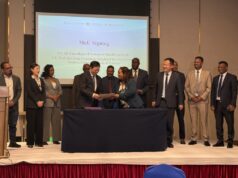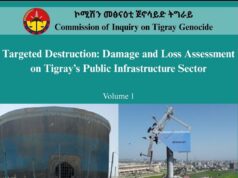Mekelle, November 6, 2025 (Tigray Mass Media Agency) — A new report by the Commission of Inquiry for Tigray Genocide (CITG) titled “Reversed Decades: War and Siege Damage and Loss of Tigray’s Natural Resources and Environment, Volume I” has exposed the extensive environmental devastation caused by the war and siege on Tigray, estimating total damages and losses at 46.6 billion US dollars. The CITG report, covering the period between November 2020 and November 2022, documents the large-scale destruction of soil and water resources, forests, biodiversity, and wildlife, reversing decades of environmental restoration achieved through community-led conservation programs.
According to the CITG report, which is available on the commission’s official website https://citghub.org/reversed-decades-war-and-siege-damage-and-loss-of-tigrays-natural-resources-and-environment-volume-1/ before the outbreak of war, Tigray was internationally recognized for its model environmental recovery and sustainable land management practices that successfully reversed desertification and restored ecological balance. However, the report notes that the war and the total siege “reversed decades of progress,” leaving Tigray’s ecosystems degraded and its natural resources deliberately targeted for destruction. The report identifies the Eritrean Defense Forces (EDF), the Ethiopian National Defense Forces (ENDF), and Amhara forces as the principal actors responsible for the widespread environmental damage.
The CITG report details catastrophic impacts on soil and water systems, estimating that more than 20,800 hectares of soil and 145,400 hectares of soil and water conservation structures were destroyed, causing losses valued at 4.23 billion US dollars. The report warns that soil fertility has been severely reduced, water sources have dried up or become polluted, and physical conservation structures were systematically dismantled. These damages, CITG concludes, have compromised agricultural productivity, accelerated desertification, and created long-term threats to human health and food security.
The CITG report also highlights that forest resources in Tigray have suffered immense destruction, with approximately 601,300 hectares of forest cover lost, equivalent to 37.5 billion US dollars in ecosystem service value. It attributes the deforestation to artillery shelling, looting, firewood extraction, and the collapse of forest management institutions during the siege. The report emphasizes that the loss of keystone tree species has disrupted local ecosystems and traditional livelihoods, while deforestation has intensified droughts, altered water cycles, and increased vulnerability to climate shocks.
According to the CITG report, the war inflicted severe damage on wildlife and biodiversity, causing local extinction of several mammal and bird species and resulting in estimated at about about 3.26 billion US dollars, while the estimated economic impact of local extinctions among conservation concern bird species was approximately 1.17 billion US dollars. The report indicates that the destruction of habitats, pollution, and widespread poaching during the war have devastated conservation areas and ecotourism potential across Tigray. CITG notes that 73% of surveyed respondents reported the complete or partial destruction of natural attractions, fauna, and flora, further eroding Tigray’s ecological and economic stability.
In addition, the CITG report documents serious environmental pollution and waste mismanagement caused by the war and siege, with losses reaching 364.66 million US dollars. It reports deliberate dumping of toxic chemicals, contamination of rivers, and the collapse of urban waste systems due to the looting of essential equipment and the breakdown of institutional capacity. The report states that urban forests and green spaces have deteriorated severely, posing ongoing risks to human and environmental health that will require long-term remediation and monitoring.
The CITG report further reveals that Tigray’s biodiversity and agricultural base were shattered, as livestock breeds, honeybee colonies, fish species, and crop varieties unique to Tigray were destroyed. The report indicates that breeding programs and genetic improvement projects were interrupted, while water poisoning and over-harvesting led to the disappearance of fish species. The total damage and loss in this sector are estimated at 10.64 million US dollars, and CITG attributes responsibility primarily to EDF and ENDF, and Amhara forces. The report warns that this genetic erosion will have lasting impacts on food security, productivity, and ecological diversity.
In its conclusion, the CITG report warns that the cumulative damage to Tigray’s natural resources and environment will have enduring effects on human livelihoods, biodiversity, and global climate balance. It asserts that the environmental destruction was not incidental but part of a deliberate campaign to weaken Tigray’s ecological foundations. CITG stresses that soil degradation, deforestation, biodiversity loss, and pollution will perpetuate poverty, displacement, and environmental decline for decades to come.
The CITG report calls for urgent interventions to restore Tigray’s devastated ecosystems, including the treatment of polluted soils, mapping and clearing of hazardous sites, halting deforestation, reforestation of degraded areas, and restoration of wildlife habitats. It also urges the pursuit of compensation-based recovery, rehabilitation, and reconstruction efforts as part of a justice framework for Tigray. CITG concludes that rebuilding Tigray’s natural environment is not only vital for local survival but also crucial for global environmental stability and climate resilience.
For full access to the report and its findings, visit the Commission of Inquiry on Tigray Genocide (CITG) at https://citghub.org/reversed-decades-war-and-siege-damage-and-loss-of-tigrays-natural-resources-and-environment-volume-1/








